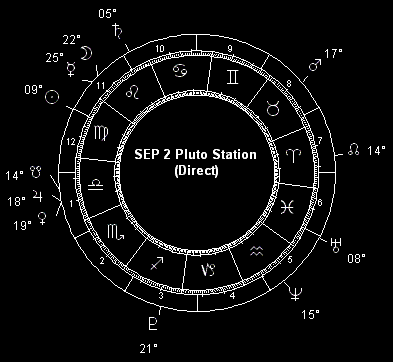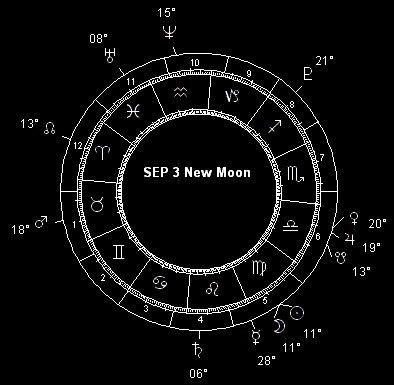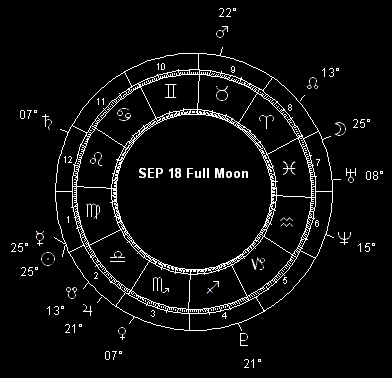If you were expecting some kind of sun sign nonsense, forget it. This is real astrology. See the section above. And if you need help deciphering the astrological glyphs in the graphics accompanying this article, see Astroglyphs: Astrological Symbols Guide. Please note: this forecast is expressed in terms of Universal Time (UT).
Forgiveness does not change the past, but it does enlarge the future.
-- Paul Boese
 No SuperMoons for September: we're done with those for the year. No eclipses either - although there are a couple waiting in the wings in October, including one that casts its shadow into late September. This isn't to say that there's a paucity of geocosmic energy to stir up Earth's crust, seas and atmosphere this month. In fact, the middle and end of September look like they could turn out to be fairly exciting in the storm, quake and volcano department. So don't store away your foul weather gear and emergency kit just yet: things are quieting down compared to last month, but they're not turning comatose.
No SuperMoons for September: we're done with those for the year. No eclipses either - although there are a couple waiting in the wings in October, including one that casts its shadow into late September. This isn't to say that there's a paucity of geocosmic energy to stir up Earth's crust, seas and atmosphere this month. In fact, the middle and end of September look like they could turn out to be fairly exciting in the storm, quake and volcano department. So don't store away your foul weather gear and emergency kit just yet: things are quieting down compared to last month, but they're not turning comatose.
One theme that ran throughout August continues all the way through September, and it has to do with Pluto's direct station. On September 2, Pluto ends the period of apparent reverse motion that it began back on March 26. Coming to an apparent standstill at 21° 49' Sagittarius and then resuming its normal direction of travel through our skies, Pluto spends all of September within a degree its station point - just as it spent the whole of August. "Coinciding with the September 1 Sun-Uranus opposition and Venus-Jupiter conjunction," as I noted in last month's forecast, "this particular Pluto station looks like the herald of some major profit taking in the financial markets." That forecast pointed to late August as the likely time for this sell-off to begin, and indeed it has. I expect it to continue off and on throughout much of September. The major market indices look awfully shaky this month, even as many commodities look strong. The Venus-Jupiter conjunction on the 1st may prop things up for a few days, but by the 6th the wild swings associated with the solar opposition to Uranus get wilder on the down side.
Mars turns retrograde October 1st, setting up the most significant and sustained Red Planet activation of the year - in a couple years, in fact. It lasts into 2006, and it signals a period of risk, danger and conflict. And since Mars is within a few degrees of its October 1 station point from September 10 onward, much of this month will stimulate the fight or flight response in one way or another. From collective violence like war to individual violence like murder and other criminality (and including the strange twilight, terrorism), and even including accidents and crashes and fires and explosions due to recklessness or evil intent and sometimes just plain bad luck (e.g. a lightning strike), it's a time to keep your eyes open, your head down and your guard up.
 The last couple months have witnessed several similar (though lesser) Red Planet activations, which have played out as predicted; coinciding with the July 7 London mass transit bombings and the terror attacks at Sharm el-Sheikh, Egypt on July 23, as well as the August 9 chemical plant explosions in Michigan. The sad truth is that things get worse in this regard, before they get better. September is just the warm-up for the most prominent Mars phase since the 2003 Mars super perigee. It will peak in early November as the Sun opposes Mars while the Red Planet squares Saturn. Stay alert, avoid places (and people) associated with trouble as much as possible - and where that's not possible, then be ready.
The last couple months have witnessed several similar (though lesser) Red Planet activations, which have played out as predicted; coinciding with the July 7 London mass transit bombings and the terror attacks at Sharm el-Sheikh, Egypt on July 23, as well as the August 9 chemical plant explosions in Michigan. The sad truth is that things get worse in this regard, before they get better. September is just the warm-up for the most prominent Mars phase since the 2003 Mars super perigee. It will peak in early November as the Sun opposes Mars while the Red Planet squares Saturn. Stay alert, avoid places (and people) associated with trouble as much as possible - and where that's not possible, then be ready.
The disaster that was Hurricane Katrina is a tragic illustration of a secular lunar declination cycle, which as mentioned in my 2005 World Forecast Highlights is this year entering "the home stretch of a cycle that peaks in spring 2006, when the Moon's oscillation above and below the celestial equator hits the peak toward which it's been building since 1987. Lunar extremes like this," as I indicated last year, "point to geocosmic stress factors associated with the risk of major tidal, storm and seismic activity." Like the December 26, 2004 Sumatran earthquake and subsequent killer mega tsunami, the Hurricane Katrina catastrophe occurred as the Moon attained its maximum declination north of the equator. Compared to August before and October afterwards, September looks relatively placid. But it will have its moments when nature seems bent on destruction, to a greater or lesser degree.
First among these is the geocosmic stress window associated with the new moon at 11° 22' Virgo on the 3rd (opposing Uranus). It warns of a new outburst of stormy weather with high winds, heavy precipitation and violent electrical storms from the 1st through the 6th. Have your storm kit ready, your batteries fresh, and your foul weather options well rehearsed. Remember that heavy precipitation carries with it a risk of floods, mudslides and the like: stay tuned in to your weather radio. If traveling, or expecting someone who is, allowing for weather delays would be a good idea. And dont forget that seismic activity tends to increase under this geocosmic configuration. This means an upsurge in moderate to severe earthquakes (Richter 5 and up) as well as volcanic eruptions. In particular, slip strike faults are most likely to be active during periods such as this, as well as the end of the month. (The well known San Andreas fault is one of many slip strike types.)
 Another storm and seismic risk period will be in effect from late on the 10th through late on the 13th, in association with the Moon's south declination maximum on the 12th. Far more potent looking is the geocosmic stress window from the 15th through the 21st, which includes the lunar perigee (the Moon's closest approach to Earth) on the 16th, and the northward lunar equatorial crossing plus the full moon at 25° 16' Pisces (both on the 18th, the day of Mercury's superior conjunction with the Sun). This will be one of the two major risk cycles this month, in terms of severe storms and moderate to severe seismic activity. It's a planet-wide potential, with possible special risks around the south Atlantic US coast and the Caribbean Sea, plus Southern California, the Pacific Northwest and western Alaska in the New World; plus the eastern Mediterranean Basin, the Middle East, southern China, the Philippines and Indonesia in the Old World. Don't be complacent if your locale isn't mentioned; but if it is, it wouldn't hurt to be a little more aware of what's going on around you during this period.
Another storm and seismic risk period will be in effect from late on the 10th through late on the 13th, in association with the Moon's south declination maximum on the 12th. Far more potent looking is the geocosmic stress window from the 15th through the 21st, which includes the lunar perigee (the Moon's closest approach to Earth) on the 16th, and the northward lunar equatorial crossing plus the full moon at 25° 16' Pisces (both on the 18th, the day of Mercury's superior conjunction with the Sun). This will be one of the two major risk cycles this month, in terms of severe storms and moderate to severe seismic activity. It's a planet-wide potential, with possible special risks around the south Atlantic US coast and the Caribbean Sea, plus Southern California, the Pacific Northwest and western Alaska in the New World; plus the eastern Mediterranean Basin, the Middle East, southern China, the Philippines and Indonesia in the Old World. Don't be complacent if your locale isn't mentioned; but if it is, it wouldn't hurt to be a little more aware of what's going on around you during this period.
Last but hardly least is the storm and seismic risk cycle in effect from late on the 23rd through the 26th, associated with the Moon reaching its extreme declination north of the celestial equator on the 25th . . . which in turns merges into the solar eclipse window that lasts until October 10. This is bound to be a time of unusually strong storm and seismic activity (including Richter 5+ earthquakes and volcanic eruptions), higher than normal tides, and a risk of floods and mudslides due to heavy precipitation. Such phenomena may be largely focused in the eclipse's zone of visibility (Africa and Europe plus the Middle East and India), and more specifically to the actual eclipse path (across the Iberian Peninsula and through Africa from Algeria to Somalia). But an eclipse is a massive cosmic alignment, and there's no place on Earth beyond the reach of atmospheric and seismic upheaval at such a time. So be prepared not only in the eclipse visibility zones, but wherever you may be September 26-October 10. You should know the drill by now: allow extra time for weather delays if you must travel, pay attention to the skies and any weather alerts available to you, and check to ensure that your emergency kit is ready at hand just in case. And you might want to double-check all this if you happen to be in one of the astro-locality hot spots during the solar eclipse window. These include Hawaii, Alaska, southern California and eastern Oregon, parts of British Columbia and Alberta; the southwest coastline of South America plus eastern Peru and Colombia as well as western Venezuela; the eastern Caribbean, Canadian Maritimes and Greenland; eastern Scotland and Ireland plus the north Scandinavian coastline; along a longitudinal arc from Capetown through Warsaw; in Asia, from central Mongolia and China through Indochina into Singapore, Indonesia and along the west coast of Australia; and finally along an arc from Vladivostok through Tokyo, Papua New Guinea and New Zealand.
 SPECIAL FEATURE: This month's birthdays of the famous and infamous (with astrological birth charts)
SPECIAL FEATURE: This month's birthdays of the famous and infamous (with astrological birth charts)